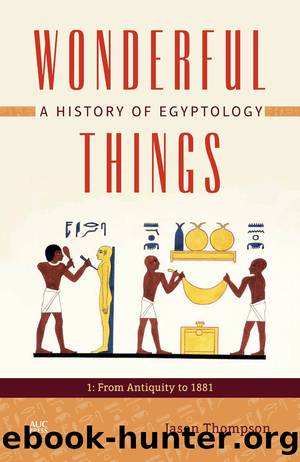Wonderful Things by Jason Thompson

Author:Jason Thompson
Language: eng
Format: epub
Publisher: The American University in Cairo Press
Published: 2014-07-14T16:00:00+00:00
9 Arrested Development
He saw all the rarities at Cairo, as also the pyramids, and sailing up the Nile, viewed the famous towns on each side of that river.
—from the “Story of Ali Cogia,” The Arabian Nights Entertainments
In his eulogy of Champollion in 1833, Silvestre de Sacy worried that Champollion’s vision would vanish like an Egyptian mirage. He hoped “that the works of the ingenious and indefatigable Champollion will yet give birth after him to heirs of his genius, who will cultivate the field that he was the first to clear.”1 Silvestre de Sacy’s worry was justified. The momentum in ancient Egyptian language studies that Champollion established was lost during the decade following his death for lack of “heirs of his genius.” Thomas Young had died in 1829 and Champollion never had time to train students at the Collège de France, for he was stricken down so soon after obtaining his chair. His early disciple Ippolito Rosellini was less a student than an assistant and second-in-command. Rosellini apparently never made extensive progress in language study, although he did publish a notable Elementa Linguae Aegyptiacae, vulgo Copticae in 1837. His career was cut short by early death in 1843 at the age of forty-two, but not before his accomplishments earned for him the title of Father of Italian Egyptology.
Champollion’s one true disciple was an Italian named François Salvolini (1809–38). Like Rosellini, Salvolini was a student of the renowned Italian linguist Abbé Joseph-Caspar Mezzofanti. He traveled to Paris in 1830 to study with Champollion and quickly proved himself useful as a research assistant and general helper. For his part, Salvolini enjoyed the advantage of first observing and then participating on something like even terms in the work of the world’s foremost Egyptologist. He was often with Champollion during his declining months. Highly recommended, Salvolini was clearly a young man of ability. Richard Lepsius found him very helpful during the early stages of his distinguished career and recalled his meeting with him as “a very special and favourable event.” Other scholars of ancient Egypt were likewise impressed, including Conradus Leemans, the leading Egyptologist of the Netherlands, who addressed his published letter on the monuments of Egypt to him.2 Salvolini published several significant works, including Analyse grammaticale raisonnée de différens texts anciens égyptiens in 1836, and left large collections of unpublished papers in France and Italy. Unfortunately, his career was even more abbreviated than Rosellini’s. Salvolini died in Paris in 1838 at the tragically young age of twenty-eight.
There was a regrettable epilogue to Salvolini’s early demise. When Jacques-Joseph Champollion-Figeac organized his late brother’s papers, he found that many were missing. They were found among Salvolini’s possessions after his death. Champollion-Figeac concluded that Salvolini had purloined them and passed off their contents as his own, and he said so when he published his brother’s Dictionnaire égyptien in 1841.3 Sir E.A. Wallis Budge detailed the entire sordid story in the introduction to his An Egyptian Hieroglyphic Dictionary in 1920 and scoffed at the idea “that a young
Download
This site does not store any files on its server. We only index and link to content provided by other sites. Please contact the content providers to delete copyright contents if any and email us, we'll remove relevant links or contents immediately.
| Archaeology | Essays |
| Historical Geography | Historical Maps |
| Historiography | Reference |
| Study & Teaching |
Underground: A Human History of the Worlds Beneath Our Feet by Will Hunt(11257)
Navigation and Map Reading by K Andrew(4553)
Sapiens by Yuval Noah Harari(4537)
Barron's AP Biology by Goldberg M.S. Deborah T(3632)
The Sympathizer by Viet Thanh Nguyen(3480)
5 Steps to a 5 AP U.S. History, 2010-2011 Edition (5 Steps to a 5 on the Advanced Placement Examinations Series) by Armstrong Stephen(3406)
Three Women by Lisa Taddeo(2920)
The Comedians: Drunks, Thieves, Scoundrels, and the History of American Comedy by Nesteroff Kliph(2790)
Water by Ian Miller(2584)
Drugs Unlimited by Mike Power(2192)
DarkMarket by Misha Glenny(1847)
The House of Government by Slezkine Yuri(1844)
The Library Book by Susan Orlean(1737)
A Short History of Drunkenness by Forsyth Mark(1720)
Revived (Cat Patrick) by Cat Patrick(1678)
The Woman Who Smashed Codes by Jason Fagone(1649)
The House of Rothschild: Money's Prophets, 1798-1848 by Niall Ferguson(1618)
And the Band Played On by Randy Shilts(1615)
Birth by Tina Cassidy(1572)
